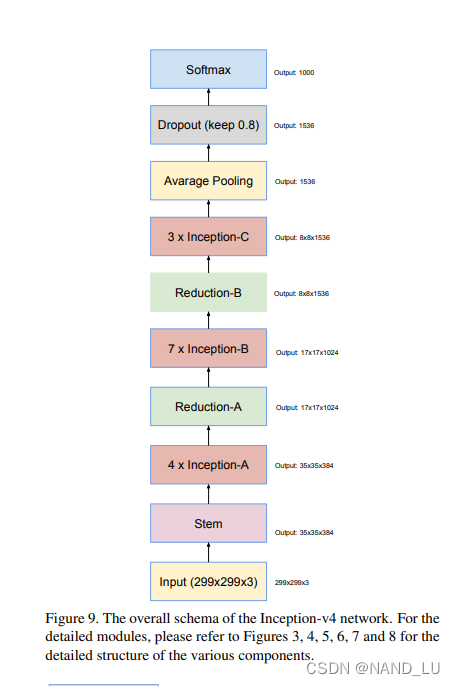基于PyTorch实现 Inception-ResNet-V1
1、论文地址
Inception-ResNet and the Impact of Residual Connections on Learning
2 、网络框架
Stem
1.框架图
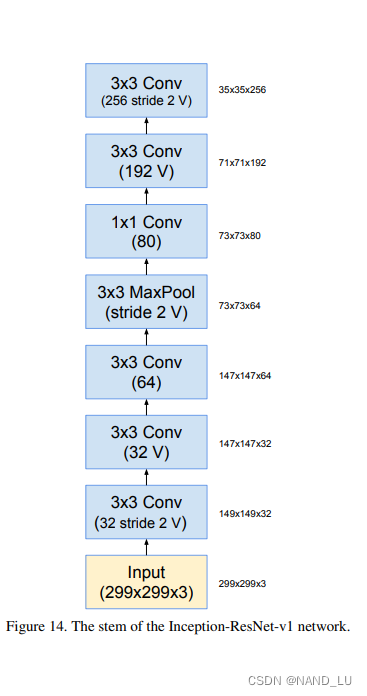
2.代码实现
因为要经常用,所以先定义一个3x3卷积,1x1卷积
class conv3x3(nn.Module):
def __init__(self, in_planes, out_channels, stride=1, padding=0):
super(conv3x3, self).__init__()
self.conv3x3 = nn.Sequential(
nn.Conv2d(in_planes, out_channels, kernel_size=3, stride=stride, padding=padding),#卷积核为3x3
nn.BatchNorm2d(out_channels),#BN层,防止过拟合以及梯度爆炸
nn.ReLU()#激活函数
)
def forward(self, input):
return self.conv3x3(input)
class conv1x1(nn.Module):
def __init__(self, in_planes, out_channels, stride=1, padding=0):
super(conv1x1, self).__init__()
self.conv1x1 = nn.Sequential(
nn.Conv2d(in_planes, out_channels, kernel_size=1, stride=stride, padding=padding),#卷积核为1x1
nn.BatchNorm2d(out_channels),
nn.ReLU()
)
def forward(self, input):
return self.conv1x1(input)
stride 2 代表步长为2
V 是TF中的padding="Valid" == pytorch中的padding=0
V 是TF中的padding="Same" == pytorch中的padding=1 with zero padding(用0填充)
但是我复现的时候没完全按图示来,可能是前面那步出错了,导致后面特征图对不上了,自己改了一下padding,懒得改回来了
class StemV1(nn.Module):
def __init__(self, in_planes):
super(StemV1, self).__init__()
self.conv1 = conv3x3(in_planes =in_planes,out_channels=32,stride=2, padding=0)
self.conv2 = conv3x3(in_planes=32, out_channels=32, stride=1, padding=0)
self.conv3 = conv3x3(in_planes=32, out_channels=64, stride=1, padding=1)
self.maxpool = nn.MaxPool2d(kernel_size=3, stride=2, padding=0)
self.conv4 = conv3x3(in_planes=64, out_channels=64, stride=1, padding=1)
self.conv5 = conv1x1(in_planes =64,out_channels=80, stride=1, padding=0)
self.conv6 = conv3x3(in_planes=80, out_channels=192, stride=1, padding=0)
self.conv7 = conv3x3(in_planes=192, out_channels=256, stride=2, padding=0)
def forward(self, x):
x = self.conv1(x)
x = self.conv2(x)
x = self.conv3(x)
x = self.maxpool(x)
x = self.conv4(x)
x = self.conv5(x)
x = self.conv6(x)
x = self.conv7(x)
return x
Inception_ResNet_A
1、框架图
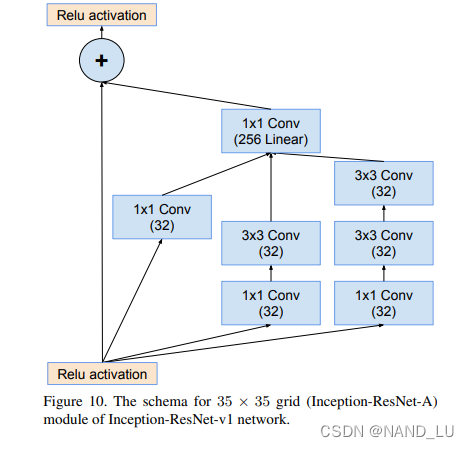
2、代码实现
class Inception_ResNet_A(nn.Module):
def __init__(self, input ):
super(Inception_ResNet_A, self).__init__()
self.conv1 = conv1x1(in_planes =input,out_channels=32,stride=1, padding=0)
self.conv2 = conv3x3(in_planes=32, out_channels=32, stride=1, padding=1)
self.line = nn.Conv2d(96, 256, 1, stride=1, padding=0, bias=True)
self.relu = nn.ReLU()
def forward(self, x):
c1 = self.conv1(x)
# print("c1",c1.shape)
c2 = self.conv1(x)
# print("c2", c2.shape)
c3 = self.conv1(x)
# print("c3", c3.shape)
c2_1 = self.conv2(c2)
# print("c2_1", c2_1.shape)
c3_1 = self.conv2(c3)
# print("c3_1", c3_1.shape)
c3_2 = self.conv2(c3_1)
# print("c3_2", c3_2.shape)
cat = torch.cat([c1, c2_1, c3_2],dim=1)#torch.Size([4, 96, 15, 15])
# print("x",x.shape)
line = self.line(cat)
# print("line",line.shape)
out =x+line
out = self.relu(out)
return out
Reduction_A
1、框架图
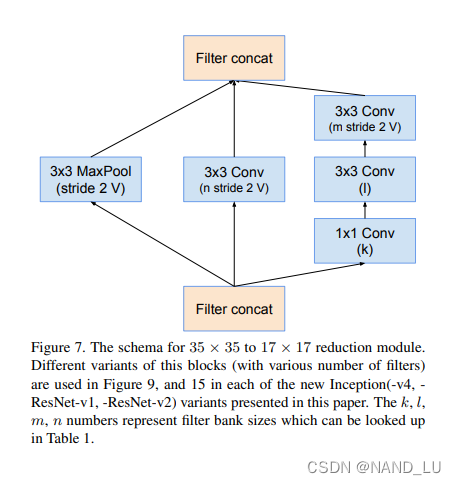
2、代码实现
class Reduction_A(nn.Module):
def __init__(self, input,n=384,k=192,l=224,m=256):
super(Reduction_A, self).__init__()
self.maxpool = nn.MaxPool2d(kernel_size=3, stride=2, padding=0)
self.conv1 = conv3x3(in_planes=input, out_channels=n,stride=2,padding=0)
self.conv2 = conv1x1(in_planes=input, out_channels=k,padding=1)
self.conv3 = conv3x3(in_planes=k, out_channels=l,padding=0)
self.conv4 = conv3x3(in_planes=l, out_channels=m,stride=2,padding=0)
def forward(self, x):
c1 = self.maxpool(x)
# print("c1",c1.shape)
c2 = self.conv1(x)
# print("c2", c2.shape)
c3 = self.conv2(x)
# print("c3", c3.shape)
c3_1 = self.conv3(c3)
# print("c3_1", c3_1.shape)
c3_2 = self.conv4(c3_1)
# print("c3_2", c3_2.shape)
cat = torch.cat([c1, c2,c3_2], dim=1)
return cat
Inception_ResNet_B
1、框架图
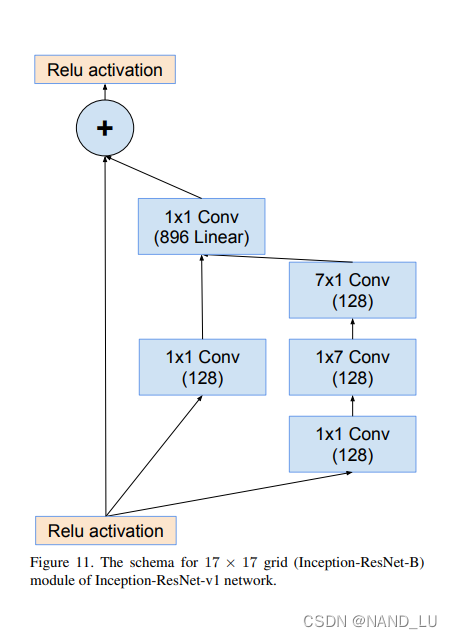
2、代码实现
class Inception_ResNet_B(nn.Module):
def __init__(self, input):
super(Inception_ResNet_B, self).__init__()
self.conv1 = conv1x1(in_planes =input,out_channels=128,stride=1, padding=0)
self.conv1x7 = nn.Conv2d(in_channels=128,out_channels=128,kernel_size=(1,7), padding=(0,3))
self.conv7x1 = nn.Conv2d(in_channels=128, out_channels=128,kernel_size=(7,1), padding=(3,0))
self.line = nn.Conv2d(256, 896, 1, stride=1, padding=0, bias=True)
self.relu = nn.ReLU()
def forward(self, x):
c1 = self.conv1(x)
# print("c1",c1.shape)
c2 = self.conv1(x)
# print("c2", c2.shape)
c2_1 = self.conv1x7(c2)
# print("c2_1", c2_1.shape)
c2_1 = self.relu(c2_1)
c2_2 = self.conv7x1(c2_1)
# print("c2_2", c2_2.shape)
c2_2 = self.relu(c2_2)
cat = torch.cat([c1, c2_2], dim=1)
line = self.line(cat)
out =x+line
out = self.relu(out)
# print("out", out.shape)
return out
Reduction_B
1、框架图
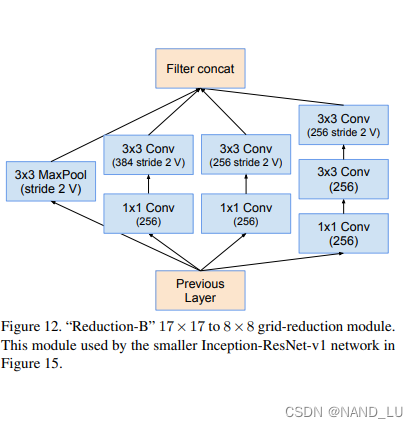
2、代码实现
class Reduction_B(nn.Module):
def __init__(self, input):
super(Reduction_B, self).__init__()
self.maxpool = nn.MaxPool2d(kernel_size=3, stride=2, padding=1)
self.conv1 = conv1x1(in_planes=input, out_channels=256, padding=1)
self.conv2 = conv3x3(in_planes=256, out_channels=384, stride=2, padding=0)
self.conv3 = conv3x3(in_planes=256, out_channels=256,stride=2, padding=0)
self.conv4 = conv3x3(in_planes=256, out_channels=256, padding=1)
self.conv5 = conv3x3(in_planes=256, out_channels=256, stride=2, padding=0)
def forward(self, x):
c1 = self.maxpool(x)
# print("c1", c1.shape)
c2 = self.conv1(x)
# print("c2", c2.shape)
c3 = self.conv1(x)
# print("c3", c3.shape)
c4 = self.conv1(x)
# print("c4", c4.shape)
c2_1 = self.conv2(c2)
# print("cc2_1", c2_1.shape)
c3_1 = self.conv3(c3)
# print("c3_1", c3_1.shape)
c4_1 = self.conv4(c4)
# print("c4_1", c4_1.shape)
c4_2 = self.conv5(c4_1)
# print("c4_2", c4_2.shape)
cat = torch.cat([c1, c2_1, c3_1,c4_2], dim=1)
# print("cat", cat.shape)
return cat
Inception_ResNet_C
1、框架图
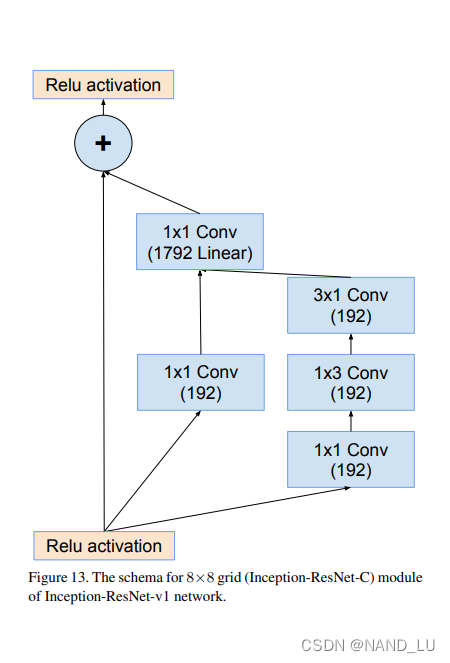
2、代码实现
class Inception_ResNet_C(nn.Module):
def __init__(self, input):
super(Inception_ResNet_C, self).__init__()
self.conv1 = conv1x1(in_planes=input, out_channels=192, stride=1, padding=0)
self.conv1x3 = nn.Conv2d(in_channels=192, out_channels=192, kernel_size=(1, 3), padding=(0,1))
self.conv3x1 = nn.Conv2d(in_channels=192, out_channels=192, kernel_size=(3, 1), padding=(1,0))
self.line = nn.Conv2d(384, 1792, 1, stride=1, padding=0, bias=True)
self.relu = nn.ReLU()
def forward(self, x):
c1 = self.conv1(x)
# print("x", x.shape)
# print("c1",c1.shape)
c2 = self.conv1(x)
# print("c2", c2.shape)
c2_1 = self.conv1x3(c2)
# print("c2_1", c2_1.shape)
c2_1 = self.relu(c2_1)
c2_2 = self.conv3x1(c2_1)
# print("c2_2", c2_2.shape)
c2_2 = self.relu(c2_2)
cat = torch.cat([c1, c2_2], dim=1)
# print("cat", cat.shape)
line = self.line(cat)
out = x+ line
# print("out", out.shape)
out = self.relu(out)
return out
Inception_ResNet_V1
代码实现
class Inception_ResNet(nn.Module):
def __init__(self,classes=2):
super(Inception_ResNet, self).__init__()
blocks = []
blocks.append(StemV1(in_planes=3))
for i in range(5):
blocks.append(Inception_ResNet_A(input=256))
blocks.append(Reduction_A(input=256))
for i in range(10):
blocks.append(Inception_ResNet_B(input=896))
blocks.append(Reduction_B(input=896))
for i in range(10):
blocks.append(Inception_ResNet_C(input=1792))
self.features = nn.Sequential(*blocks)
self.avepool = nn.AvgPool2d(kernel_size=3)
self.dropout = nn.Dropout(p=0.2)
self.linear = nn.Linear(1792, classes)
def forward(self,x):
x = self.features(x)
# print("x",x.shape)
x = self.avepool(x)
# print("avepool", x.shape)
x = self.dropout(x)
# print("dropout", x.shape)
x = x.view(x.size(0), -1)
x = self.linear(x)
return x
